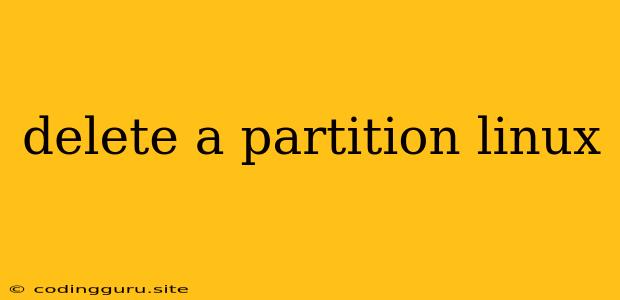Deleting a Partition in Linux: A Comprehensive Guide
Linux partitions are essential for organizing your hard drive and managing different operating systems or data sets. However, there might come a time when you need to remove a partition, perhaps to resize another partition or free up space. While this process might sound intimidating, it's actually quite straightforward with the right tools and knowledge.
This article will walk you through the process of deleting a partition in Linux, providing step-by-step instructions and crucial considerations to ensure a safe and successful operation.
Understanding Partition Deletion
Before diving into the practical steps, it's crucial to understand the implications of deleting a partition.
- Data Loss: Deleting a partition will permanently erase all data stored within that partition. Ensure you have backed up any essential files before proceeding.
- Disk Space Recovery: Deleting a partition allows you to reclaim the disk space occupied by it, which can then be used for other purposes like creating new partitions or expanding existing ones.
- System Stability: If you are deleting a partition that contains critical system files, you may encounter boot issues. It is strongly advised to consult with a Linux expert before deleting such partitions.
Essential Tools and Commands
The primary tool for managing partitions in Linux is fdisk, a command-line utility that provides a powerful interface for interacting with disk drives. Other tools like parted and gdisk offer graphical interfaces for easier manipulation, but fdisk remains the most widely used and powerful option.
Steps to Delete a Partition in Linux
1. Identifying the Partition to Delete
Before proceeding, it is vital to identify the exact partition you intend to delete. This can be done using the fdisk -l command. This command lists all the partitions on your system, displaying their size, type, and other relevant information.
sudo fdisk -l
Example Output:
Disk /dev/sda: 1000.2 GiB, 1073741824000 bytes, 2097152 sectors
Units: sectors of 1 * 512 = 512 bytes
Sector size (logical/physical): 512 bytes / 4096 bytes
I/O size (minimum/optimal): 4096 bytes / 4096 bytes
Disklabel type: gpt
Disk identifier: 0C9F7524-4547-4469-8A5B-B7414B2076EF
Device Start End Sectors Size Type
/dev/sda1 2048 4095 2048 1M EFI System
/dev/sda2 4096 131071 126976 62.5M Linux Filesystem
/dev/sda3 131072 2097151 1966080 962M Linux Filesystem
/dev/sda4 2097152 2097151999 1896404478 907.6G Linux Filesystem
In this example, /dev/sda4 is the partition you might want to delete.
2. Entering fdisk
Once you've identified the partition, use the following command to enter the fdisk utility:
sudo fdisk /dev/sdX
Replace /dev/sdX with the actual device name from the fdisk -l output.
3. Deleting the Partition
- List Partitions: Use the
pcommand to list the partitions on the disk. - Delete Partition: Use the
dcommand to delete a partition. You'll be prompted for the partition number. Enter the number corresponding to the partition you want to delete.
fdisk /dev/sda
Command (m for help): p
Command (m for help): d
Partition number (1-4): 4
4. Writing Changes
After deleting the partition, you need to save the changes by using the following commands:
Command (m for help): w
5. Verifying Deletion
After exiting fdisk, you can verify that the partition has been deleted using the fdisk -l command again. The deleted partition will no longer be listed in the output.
Important Considerations
- Backups: Always create backups of essential data before deleting any partition. This will safeguard your valuable information against accidental data loss.
- Boot Partition: Do not delete the partition containing your operating system's boot files. This can render your system unbootable.
- Root Partition: Avoid deleting the root partition (usually
/dev/sda1or/dev/sda2) as it contains critical system files. - File System: If the partition you are deleting has a file system, like ext4 or NTFS, you might need to format the freed space before using it.
Conclusion
Deleting a partition in Linux can be a necessary step for various reasons, but it's crucial to exercise caution and follow proper procedures. By carefully identifying the partition, using the correct commands, and taking necessary precautions, you can safely delete a partition in Linux and reclaim valuable disk space. Remember, data loss is permanent, so always backup your data before making any irreversible changes.
